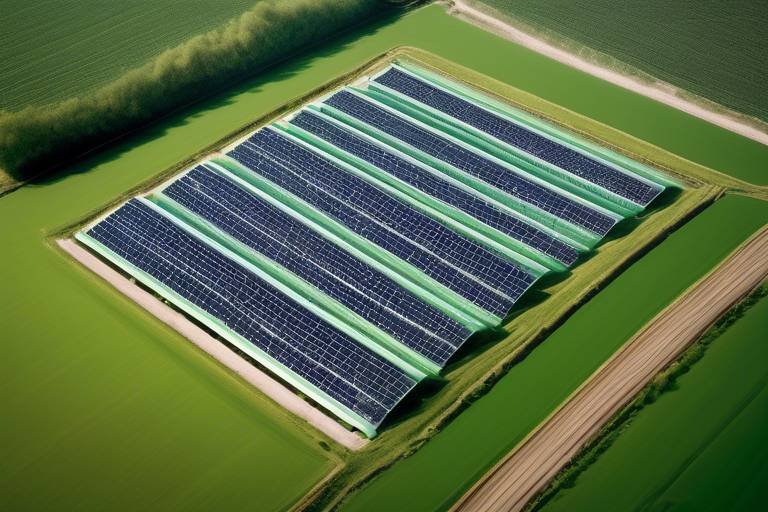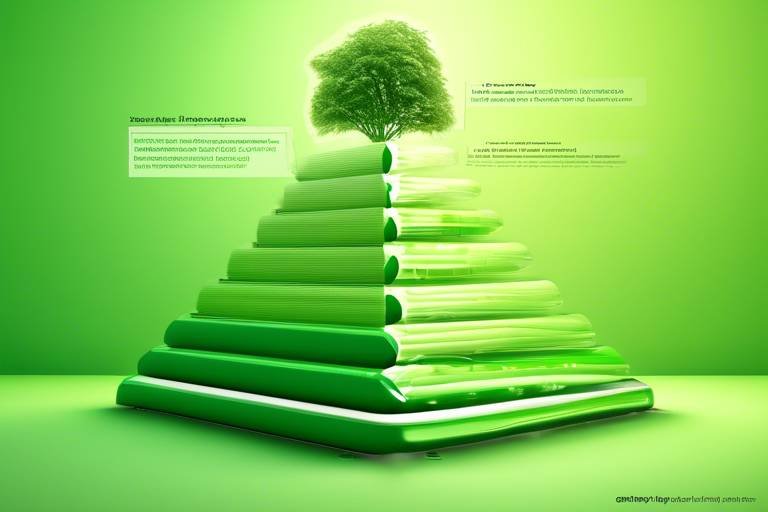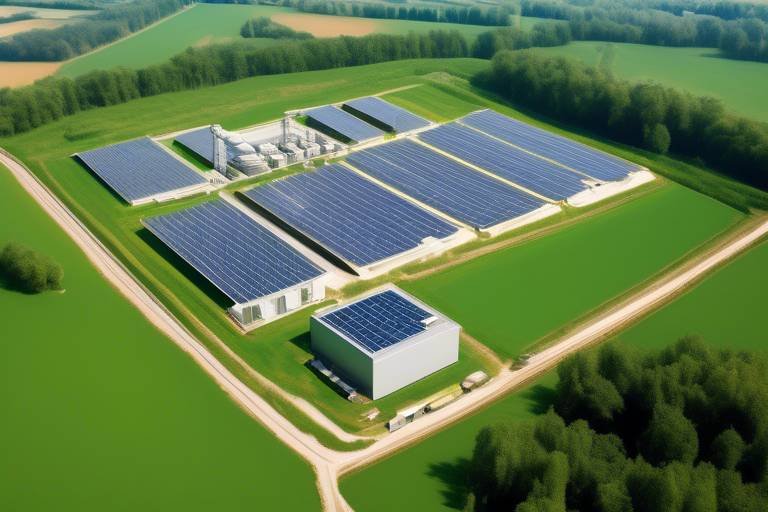Can Your Business Run Completely on Green Energy?
In today’s world, the concept of sustainability is more than just a buzzword; it's a critical component of modern business strategy. The question on many entrepreneurs' minds is, “Can my business truly operate on green energy alone?” The answer is a resounding yes, but it comes with its own set of challenges and benefits. As we dive into this topic, we’ll explore the feasibility of running a business entirely on renewable energy sources, the advantages of making such a transition, and the practical steps you can take to make it happen.
First off, let's consider the environmental impact. Traditional energy sources, like fossil fuels, contribute significantly to climate change and environmental degradation. By shifting to green energy, businesses can drastically reduce their carbon footprint. Imagine the impact if every company made this switch—cleaner air, healthier communities, and a more sustainable planet. But it’s not just about saving the Earth; it’s also about saving money. Many businesses find that investing in renewable energy leads to long-term cost savings, especially as energy prices continue to fluctuate.
Moreover, operating on green energy can enhance your corporate reputation. In a market where consumers are increasingly eco-conscious, businesses that prioritize sustainability often enjoy a competitive edge. Customers are more likely to support brands that align with their values, and being a green business can attract new clientele, bolster employee morale, and increase overall brand loyalty.
However, transitioning to renewable energy isn't without its hurdles. Many business owners may wonder about the initial costs of setting up solar panels or wind turbines. While the upfront investment can be significant, it's essential to view it as a long-term strategy. Over time, the savings on energy bills, along with potential government incentives, can lead to a positive return on investment. Plus, with advancements in technology, the cost of renewable energy solutions continues to decrease.
As we explore the various types of renewable energy sources available for businesses, it’s crucial to understand their unique advantages. From solar panels harnessing sunlight to wind turbines capturing the breeze, each energy source offers distinct benefits that can cater to different business needs. For instance, solar energy can be implemented through rooftop installations or larger solar farms, while wind energy can be utilized through on-site turbines or by purchasing energy credits.
In conclusion, the journey to running a business entirely on green energy is not only feasible but also beneficial in numerous ways. With the right planning, investment, and commitment, any business can contribute to a more sustainable future while reaping the rewards of cleaner energy. So, are you ready to take the plunge into the world of renewable energy?
- What are the main types of renewable energy? The main types include solar, wind, hydroelectric, and geothermal energy.
- How much does it cost to switch to renewable energy? The costs vary depending on the type of energy, scale of implementation, and available incentives, but many businesses see a return on investment over time.
- Are there government incentives for businesses going green? Yes, many governments offer grants, tax credits, and other incentives to encourage businesses to invest in renewable energy.
- What challenges might I face when transitioning to green energy? Common challenges include initial costs, space limitations, regulatory hurdles, and maintenance concerns.

The Importance of Green Energy
In today's rapidly changing world, the shift towards green energy has become not just a trend but a necessity for businesses aiming to thrive. The importance of transitioning to renewable energy sources cannot be overstated, as it contributes significantly to the well-being of our planet, while also offering a myriad of benefits for companies themselves. Imagine a world where businesses operate sustainably, reducing their carbon footprints while simultaneously cutting costs and enhancing their brand image. Sounds appealing, right?
One of the most compelling reasons to adopt green energy is the environmental impact. Traditional energy sources, like fossil fuels, are notorious for their role in climate change, air pollution, and environmental degradation. By switching to renewable energy, businesses can significantly reduce their greenhouse gas emissions. This not only helps combat global warming but also promotes a cleaner and healthier environment for future generations. Think of it as a responsibility that businesses have towards the planet.
On top of that, there's the undeniable financial incentive. Many companies have discovered that investing in renewable energy can lead to substantial cost savings in the long run. While the initial investment might seem daunting, the operational costs associated with renewable energy sources are often much lower than those of traditional energy. For instance, solar panels and wind turbines can generate free energy once installed, drastically reducing monthly utility bills. Furthermore, numerous government incentives and tax breaks are available to businesses that invest in green energy, making it even more financially viable.
Additionally, adopting green energy can enhance a company's corporate reputation. In an era where consumers are increasingly eco-conscious, businesses that prioritize sustainability can stand out in a crowded market. Companies that showcase their commitment to renewable energy often attract more customers, build stronger brand loyalty, and even enjoy a competitive edge. It’s like wearing a badge of honor in the business world; customers are more likely to support a brand that aligns with their values, especially when it comes to environmental responsibility.
However, it's essential to acknowledge that the transition to green energy isn't without its challenges. Businesses must navigate various obstacles, including regulatory hurdles, the initial capital required for investment, and the need for infrastructure changes. Yet, these challenges can often be mitigated with careful planning and strategic partnerships. By approaching the transition with a solid strategy, businesses can not only overcome these hurdles but also position themselves as leaders in the green energy movement.
In summary, the importance of green energy for businesses today is clear. It's not just about reducing environmental impact; it's about cost savings, enhancing corporate reputation, and fostering innovation. As the world continues to grapple with climate change and resource scarcity, businesses that embrace renewable energy will not only contribute to a sustainable future but also pave the way for their own success. Are you ready to join the green revolution?

Types of Renewable Energy Sources
Understanding the different types of renewable energy sources is essential for businesses considering a transition to green energy. Each type comes with its own unique set of advantages and applications, making it crucial to assess which option aligns best with your business model. Let's dive into the most common types of renewable energy sources that businesses can utilize today.
Solar Energy is perhaps the most recognized form of renewable energy. It harnesses the power of the sun through photovoltaic cells or solar panels. Businesses can choose from various solar solutions, such as rooftop installations, which are ideal for companies with ample roof space, or even larger solar farms that can generate significant energy for multiple operations. The beauty of solar energy lies in its scalability; whether you’re a small startup or a large corporation, there’s a solar solution tailored for you.
Next up is Wind Energy, which captures the kinetic energy of wind through turbines. This form of energy is especially beneficial for businesses located in areas with consistent wind patterns. Companies can consider installing on-site wind turbines or purchasing wind energy credits to offset their carbon footprint. Wind energy is not only sustainable but also a cost-effective option in the long run, given the right conditions.
Hydroelectric Energy is another powerful renewable source, utilizing the flow of water to generate electricity. This method is particularly effective for businesses located near rivers or large bodies of water. Hydroelectric power plants can provide a continuous supply of energy, making it a reliable choice for companies with high energy demands. However, it’s essential to consider the environmental impact and regulatory requirements associated with hydroelectric projects.
Finally, we have Geothermal Energy, which taps into the Earth’s internal heat. This energy source is particularly useful for businesses in geologically active areas. By drilling into the ground, companies can access steam or hot water to generate electricity or provide direct heating. Although geothermal energy systems can require a significant upfront investment, they often lead to substantial long-term savings and reduced carbon emissions.
In summary, the choice of renewable energy source for your business will depend on various factors, including location, energy needs, and budget. Each type has its own set of advantages that can contribute to a more sustainable and cost-effective operation. As you consider these options, remember that transitioning to green energy is not just about reducing costs; it’s also about enhancing your corporate reputation and contributing to a healthier planet.
For a quick reference, here’s a table summarizing the key renewable energy sources:
| Energy Source | Advantages | Best For |
|---|---|---|
| Solar Energy | Scalable, widely available, low maintenance | Businesses with roof space or land for solar farms |
| Wind Energy | Cost-effective, sustainable, minimal emissions | Locations with consistent wind patterns |
| Hydroelectric Energy | Reliable, continuous power supply | Businesses near rivers or water sources |
| Geothermal Energy | Long-term savings, reduced emissions | Companies in geologically active areas |

Solar Energy Solutions
When it comes to harnessing the power of the sun, businesses have a plethora of at their disposal. From small startups to large corporations, the transition to solar energy is not just a trend; it’s a smart move towards sustainability. Imagine powering your entire office with clean energy, reducing your carbon footprint, and saving money all at the same time! The beauty of solar energy lies in its versatility. Businesses can opt for rooftop solar installations, where solar panels are mounted on the roofs of buildings, or they can invest in larger-scale solutions like solar farms that generate substantial energy for multiple operations.
Rooftop installations are particularly appealing for urban businesses that may not have the space for extensive ground installations. They can significantly reduce electricity bills and often come with the added benefit of government incentives. On the other hand, solar farms can be a game changer for companies with ample land. These farms not only supply energy but can also be a source of revenue if the energy is sold back to the grid. In fact, many businesses are finding that investing in solar can turn into a profitable venture rather than just an expense.
Furthermore, solar energy systems are becoming increasingly efficient and affordable. The technology has advanced leaps and bounds, making it possible for businesses of all sizes to adopt solar solutions. With the right setup, companies can achieve energy independence, meaning they rely less on traditional energy sources that fluctuate in price and availability. This independence can be a game changer in today’s volatile energy market.
However, it's essential to approach solar energy solutions with a clear plan. Businesses must assess their energy needs, evaluate available space, and consider local regulations. For instance, some areas offer better sunlight exposure than others, which can affect the efficiency of solar panels. Additionally, understanding the financial implications is crucial. While the initial investment might seem daunting, the long-term savings can outweigh these costs significantly.
To help visualize the potential benefits of solar energy, consider the following table that outlines the key advantages:
| Advantage | Description |
|---|---|
| Cost Savings | Reduction in electricity bills and potential revenue from selling excess energy. |
| Environmental Impact | Significantly lowers carbon emissions and contributes to a sustainable future. |
| Energy Independence | Less reliance on fossil fuels and traditional energy sources, leading to greater stability. |
| Government Incentives | Access to various grants and tax benefits aimed at promoting renewable energy. |
In conclusion, solar energy solutions present a viable path for businesses looking to operate sustainably while also enjoying financial benefits. The transition may come with its challenges, but the potential rewards make it a worthy endeavor. As more businesses embrace solar energy, we can collectively move towards a greener future, proving that sustainability and profitability can go hand in hand.
- What is the initial cost of installing solar panels for a business? The cost can vary widely based on the size of the installation and location, but many businesses can find financing options to ease the burden.
- How long does it take to see a return on investment? Typically, businesses can expect to see ROI within 5 to 7 years, depending on energy consumption and local incentives.
- Are there maintenance costs associated with solar panels? Yes, while solar panels are generally low maintenance, occasional cleaning and inspections are recommended to ensure efficiency.

Cost and ROI of Solar Installations
When considering solar energy installations, one of the most pressing questions for businesses is, "What will it cost me, and how long until I see a return on my investment?" The initial costs of solar installations can vary significantly depending on factors such as system size, location, and the type of solar technology used. On average, businesses can expect to spend anywhere from $15,000 to $100,000 for a commercial solar system. However, this is just the tip of the iceberg.
To truly grasp the financial implications, let's break down the costs. Typically, the major expenses include the solar panels, inverters, installation labor, and any necessary permits. But the good news is that many governments offer incentives and tax credits to help offset these costs. For instance, the Federal Investment Tax Credit (ITC) allows businesses to deduct a significant percentage of their solar installation costs from their federal taxes. In 2023, this percentage stands at 26%, making it a fantastic opportunity for businesses to save money.
Now, let’s talk about the return on investment (ROI). The ROI from solar energy can be substantial, with many businesses seeing payback periods of 5 to 7 years. This means that after this period, the energy savings from the solar installation can effectively cover the initial investment. After the payback period, businesses can enjoy reduced energy bills, which can lead to substantial savings over the lifespan of the solar system, typically around 25 to 30 years.
| Cost Breakdown | Average Cost |
|---|---|
| Solar Panels | $8,000 - $40,000 |
| Inverters | $1,000 - $5,000 |
| Installation Labor | $2,000 - $10,000 |
| Permits and Fees | $500 - $2,000 |
When assessing the ROI, it’s also essential to consider the impact of rising electricity rates. As traditional energy costs increase, the savings from solar installations become even more pronounced. Additionally, businesses can enhance their sustainability image, potentially attracting more customers who value environmental responsibility.
However, it's crucial to remember that while the financial benefits are compelling, solar installations are not without their challenges. Factors such as location, available sunlight, and local regulations can affect both the installation costs and the overall ROI. Therefore, before diving into a solar project, businesses should conduct a thorough analysis, possibly with the help of a solar consultant, to ensure they are making an informed decision.
In summary, while the upfront costs of solar installations may seem daunting, the long-term benefits in terms of ROI, energy savings, and enhanced corporate reputation make it a worthwhile investment for many businesses. By taking advantage of available incentives and carefully planning their solar strategy, companies can significantly improve their bottom line while contributing to a more sustainable future.
- What is the average payback period for solar installations? The average payback period is typically between 5 to 7 years.
- Are there any government incentives for solar installations? Yes, many governments offer tax credits and incentives, such as the Federal Investment Tax Credit (ITC), which allows businesses to deduct a percentage of their solar costs from their taxes.
- How much can businesses save on energy bills with solar? Savings can vary, but many businesses see substantial reductions in their energy bills, especially as traditional energy costs rise.

Challenges in Solar Adoption
While the transition to solar energy offers numerous benefits, it's not without its challenges. Many businesses find themselves navigating a maze of obstacles that can complicate the adoption process. One of the most significant barriers is the initial cost of solar installations. Although prices have decreased over the years, the upfront investment can still be substantial. This can deter businesses, especially small to medium-sized enterprises, from making the leap into renewable energy.
Another hurdle is the availability of space. For businesses located in urban areas, rooftop installations might not be feasible due to limited space or structural limitations. Even for those with adequate rooftops, the orientation and shading from nearby buildings or trees can significantly affect the efficiency of solar panels. This leads to the question: how can businesses maximize their solar potential if they lack the necessary space?
Furthermore, businesses often face regulatory hurdles. The legal landscape surrounding solar energy can be complex, varying significantly from one region to another. Companies must navigate local zoning laws, building codes, and interconnection agreements, which can be time-consuming and frustrating. To add to this, obtaining the necessary permits can delay installation timelines, making it challenging for businesses to plan their energy transition effectively.
Maintenance is another critical concern. While solar panels are generally low-maintenance, they still require regular cleaning and occasional repairs. Businesses may worry about the long-term upkeep of their solar systems, especially if they lack the in-house expertise to manage these tasks. This concern can be amplified by the fear of unforeseen costs associated with repairs or replacements.
Lastly, the fluctuating energy market can create uncertainty around the return on investment (ROI) for solar energy. Energy prices can vary widely, and businesses may hesitate to invest in solar if they perceive that the savings could be negated by future market changes. To mitigate this risk, organizations need to conduct thorough market research and financial forecasting before committing to solar energy solutions.
Despite these challenges, many businesses are finding innovative ways to overcome these obstacles. By leveraging government incentives, seeking partnerships with solar providers, and employing creative financing options, companies can navigate the complexities of solar adoption and ultimately reap the rewards of a sustainable energy future.
- What are the main benefits of adopting solar energy for my business?
Solar energy can significantly reduce operational costs, enhance your brand's reputation, and contribute to environmental sustainability. - How much does it cost to install solar panels?
The cost can vary greatly depending on the size of the installation, location, and specific needs of your business. It’s essential to get multiple quotes and consider government incentives. - What if my business doesn't have enough roof space for solar panels?
Consider options like solar farms or community solar programs, which allow businesses to invest in solar energy without the need for on-site installations. - Are there any government incentives for businesses to switch to solar energy?
Yes, many governments offer tax credits, rebates, and grants to encourage businesses to adopt renewable energy solutions.

Wind Energy for Businesses
When it comes to harnessing the power of nature, wind energy stands out as one of the most promising renewable sources for businesses. Imagine your company operating with the breeze at its back, literally! Wind energy can provide a substantial portion of a business's electricity needs, making it an attractive option for those looking to reduce their carbon footprint while also cutting costs. But how does it work? Well, wind turbines capture the kinetic energy of wind and convert it into electricity. This process not only helps in powering your operations but also contributes to a cleaner environment, which is something that today's consumers are increasingly concerned about.
Many businesses are now considering the feasibility of on-site wind turbines. These installations can range from small turbines that power a single facility to larger setups that generate enough electricity to supply multiple locations. However, before you get swept away by the idea of spinning blades and clean energy, it’s important to understand the implications. For instance, the amount of wind energy a business can harness depends largely on its geographical location. Areas with consistent and strong winds, like coastal regions or open plains, are ideal for wind energy generation. In contrast, businesses located in areas with less wind might find it less effective.
Another option for companies that may not have the space or wind conditions for on-site turbines is to purchase wind energy credits. This approach allows businesses to invest in wind energy without the need for physical installations. By buying these credits, companies can support wind energy projects and claim that they are using renewable energy, which can enhance their corporate image. It's like buying a ticket to a concert; you might not be on stage, but you're still part of the experience!
However, it’s essential to consider the challenges associated with wind energy. For instance, the initial setup costs for wind turbines can be significant. Additionally, businesses must navigate regulatory requirements and local zoning laws that may affect installation. Maintenance is another factor; while wind turbines are generally low-maintenance, they do require periodic checks and repairs, which can add to operational costs. Despite these challenges, the long-term benefits can often outweigh the initial hurdles.
To summarize, wind energy offers a compelling opportunity for businesses to embrace sustainability while potentially reducing energy costs. With the right location, investment, and strategic planning, companies can harness the power of the wind, paving the way for a greener future. So, are you ready to let the winds of change blow through your business?
- What is wind energy? Wind energy is the process of converting wind into electricity using wind turbines.
- How can businesses utilize wind energy? Businesses can install on-site wind turbines or purchase wind energy credits to support renewable energy projects.
- What are the benefits of using wind energy? Benefits include reduced energy costs, improved corporate image, and a lower carbon footprint.
- Are there challenges in adopting wind energy? Yes, challenges include high initial costs, regulatory hurdles, and maintenance requirements.

Regulatory and Policy Considerations
Transitioning to green energy is not just about making a choice for sustainability; it also involves navigating a complex landscape of . Governments worldwide are increasingly recognizing the importance of renewable energy, leading to a plethora of regulations, incentives, and compliance requirements that can significantly impact businesses. Understanding these factors is crucial for any company looking to make the switch.
One of the primary aspects to consider is the variety of government incentives available. Many countries offer tax credits, grants, and rebates to encourage businesses to invest in renewable energy sources. For instance, in the United States, the Investment Tax Credit (ITC) allows businesses to deduct a significant percentage of the cost of solar energy systems from their federal taxes. This can make the initial investment much more manageable and appealing. Additionally, some states have their own programs that provide further financial support for renewable energy projects.
However, it’s not just about the money. Compliance with local, state, and federal regulations can be a daunting task. Businesses must ensure that they adhere to various environmental standards and reporting requirements. For example, if a company plans to install wind turbines, it may need to conduct environmental impact assessments and obtain special permits. This process can be time-consuming and may require expert guidance to navigate successfully.
Another critical factor is the grid connection. In many regions, businesses that generate their own renewable energy must still connect to the local power grid. This connection often comes with its own set of regulations. Companies need to understand how net metering works, which allows them to receive credit for the excess energy they produce and feed back into the grid. Understanding these regulations can help businesses maximize their return on investment.
Moreover, policy stability is a vital consideration. Frequent changes in government policies can create uncertainty for businesses looking to invest in renewable energy. A stable policy environment encourages long-term planning and investment. Companies should keep an eye on legislative trends and engage with local policymakers to advocate for supportive regulations that foster a healthier environment for renewable energy investments.
In summary, while the transition to green energy offers numerous benefits, it is essential for businesses to thoroughly understand the regulatory landscape. Engaging with experts in energy policy, staying informed about government incentives, and ensuring compliance with all regulations will not only smooth the transition but also enhance the overall success of renewable energy initiatives.
- What are the main government incentives for renewable energy?
Incentives vary by country and region but often include tax credits, grants, and rebates aimed at reducing the upfront costs of renewable energy installations.
- How can I ensure compliance with renewable energy regulations?
Consulting with legal experts in energy policy can help you navigate the complex regulatory landscape and ensure that your business meets all necessary compliance requirements.
- What is net metering, and how does it work?
Net metering allows businesses that generate their own renewable energy to receive credits for the excess energy they supply back to the grid, effectively lowering their energy costs.

Government Incentives for Green Energy
Transitioning to green energy can seem like a daunting task for many businesses, but the good news is that governments around the world are stepping up to encourage this shift. Government incentives play a crucial role in making renewable energy more accessible and affordable for businesses. These incentives can take many forms, including tax credits, grants, and rebates, all designed to ease the financial burden of investing in renewable energy technologies.
For instance, many countries offer tax credits for businesses that install solar panels or wind turbines. These credits can significantly reduce the upfront costs, allowing companies to recoup their investments more quickly. In the United States, the federal solar tax credit allows businesses to deduct a substantial percentage of their solar installation costs from their federal taxes, making solar energy an attractive option.
Moreover, some local governments provide grants specifically for renewable energy projects. These grants can cover a portion of the installation costs or fund research and development for innovative energy solutions. For example, a small business looking to install a geothermal heating system might find a local grant that covers 30% of the project costs, making the switch to green energy not just feasible, but also financially smart.
It's also worth noting that many states and municipalities have rebate programs that reward businesses for their commitment to sustainability. These rebates can apply to various renewable energy technologies, including energy-efficient appliances, electric vehicle charging stations, and energy storage systems. By taking advantage of these programs, businesses can further reduce their operational expenses while enhancing their green credentials.
However, navigating the landscape of government incentives can be tricky. Each program has its own eligibility requirements, application processes, and deadlines. Therefore, it’s essential for businesses to do their homework. Consulting with a renewable energy expert or a financial advisor familiar with these incentives can help businesses identify the best opportunities available to them.
In summary, government incentives for green energy are a vital component in supporting businesses' transition to renewable energy. By leveraging these incentives, companies can significantly lower their investment costs, enhance their sustainability efforts, and position themselves as leaders in the green economy. As the world moves toward a more sustainable future, businesses that take advantage of these programs will not only contribute to environmental preservation but also reap significant financial benefits.
- What types of government incentives are available for green energy?
Incentives can include tax credits, grants, rebates, and low-interest loans aimed at reducing the costs associated with renewable energy installations.
- How can I find out what incentives are available in my area?
Check with your local government or energy department, as they often have resources and information about available programs. Websites like the Database of State Incentives for Renewables & Efficiency (DSIRE) can also provide comprehensive information.
- Are there any specific requirements to qualify for these incentives?
Yes, eligibility criteria vary by program and may include factors like the type of renewable energy technology, the size of the installation, and the business's location.

Future Trends in Green Energy
The future of green energy is not just a whisper of hope; it's a resounding call to action that businesses can no longer ignore. As we step into a new era, the landscape of renewable energy is evolving at an astonishing pace, driven by technological advancements and a growing awareness of the need for sustainability. So, what can we expect in the coming years? Let's dive into some of the most exciting trends that are shaping the future of green energy.
One of the most significant trends is the increasing adoption of energy storage technologies. As businesses harness renewable sources like solar and wind, the challenge of intermittency arises—how do you utilize energy when the sun isn’t shining or the wind isn’t blowing? Here, battery storage systems come into play, allowing companies to store excess energy for later use. This not only maximizes efficiency but also ensures a steady energy supply, making it a game-changer for businesses aiming for complete sustainability.
Moreover, the integration of smart grid technologies is revolutionizing how energy is distributed and consumed. These advanced systems use digital technology to manage energy flow more efficiently, enabling real-time adjustments based on demand. Imagine a scenario where your business can automatically shift its energy consumption to off-peak hours when electricity is cheaper and greener. This not only cuts costs but also reduces strain on the grid, paving the way for a more sustainable energy future.
Another exciting trend is the rise of decentralized energy systems. Instead of relying solely on large power plants, businesses are increasingly looking at localized solutions like microgrids. These systems allow businesses to generate their own energy and operate independently from the traditional grid. This not only enhances energy security but also fosters resilience against outages and price fluctuations. The beauty of decentralization lies in its ability to empower businesses, giving them control over their energy sources and consumption.
Furthermore, we are witnessing a surge in corporate sustainability commitments. More and more companies are setting ambitious goals to achieve net-zero emissions, and this is driving demand for renewable energy solutions. Businesses are not just looking to comply with regulations; they are actively seeking ways to lead in sustainability. This shift is creating a ripple effect, encouraging innovation and investment in green technologies.
To illustrate these trends, consider the following table that highlights some key statistics:
| Trend | Description | Impact on Businesses |
|---|---|---|
| Energy Storage | Advancements in battery technologies for storing renewable energy. | Increases reliability and efficiency of energy use. |
| Smart Grids | Digital technology for real-time energy management. | Reduces costs and enhances operational efficiency. |
| Decentralized Systems | Localized energy generation and consumption. | Improves energy security and resilience. |
| Sustainability Commitments | Corporate goals for net-zero emissions. | Drives innovation and investment in green technologies. |
As we look to the horizon, it’s clear that the future of green energy is not just about adopting new technologies; it’s about creating a culture of sustainability within businesses. This means investing in employee training, fostering a mindset of innovation, and collaborating with other organizations to share best practices. The journey may seem daunting, but the rewards are immense—both for the planet and for the bottom line.
In conclusion, the trends in green energy are not just passing fads; they represent a fundamental shift in how businesses operate. By embracing these changes, companies can not only reduce their carbon footprint but also position themselves as leaders in sustainability. The question is, are you ready to join the green revolution?
Q: What are the main benefits of switching to green energy?
A: The main benefits include cost savings, reduced carbon emissions, improved corporate reputation, and enhanced energy security.
Q: How can small businesses afford the transition to renewable energy?
A: Many government incentives and grants are available to help offset the initial costs, along with financing options that can make the transition more manageable.
Q: Is it possible for a business to run entirely on renewable energy?
A: Yes, with the right combination of renewable energy sources, energy storage solutions, and smart energy management, businesses can operate fully on green energy.
Frequently Asked Questions
- Can my business really run entirely on green energy?
Absolutely! With the right mix of renewable energy sources like solar, wind, and hydroelectric, businesses can operate on green energy alone. It may take some planning and investment, but many companies are successfully making the switch and reaping the benefits.
- What are the main benefits of transitioning to green energy?
Transitioning to green energy can lead to significant cost savings, enhance your brand's reputation, and contribute positively to the environment. Plus, many consumers today prefer to support businesses that prioritize sustainability, which can give you a competitive edge.
- What types of renewable energy are available for businesses?
There are several types of renewable energy sources you can consider, including solar, wind, hydroelectric, and geothermal. Each has its own unique benefits and applications, so you can choose the one that best fits your business needs.
- How can solar energy benefit my business?
Solar energy can significantly reduce your operational costs and carbon footprint. Options range from rooftop installations to larger solar farms, allowing for flexibility based on your space and energy needs.
- What are the initial costs associated with solar energy installations?
While the initial costs can be significant, many businesses find that government incentives and long-term savings on energy bills provide a strong return on investment. It's essential to evaluate these costs against potential savings over time.
- What challenges might I face when adopting solar energy?
Common challenges include space limitations for installations, navigating regulatory hurdles, and ongoing maintenance concerns. However, with proper planning and support, many of these obstacles can be effectively managed.
- Is wind energy a viable option for my business?
Yes! Depending on your location, wind energy can be harnessed through on-site turbines or by purchasing wind energy credits. It's a great way to diversify your energy sources and enhance sustainability.
- What government incentives are available for green energy investments?
Many governments offer various programs, grants, and tax incentives to encourage businesses to invest in renewable energy. These can significantly offset the initial costs and make the transition more financially feasible.
- What future trends should I be aware of in green energy?
Emerging trends include advancements in energy storage technology, increased efficiency in renewable energy systems, and the growing adoption of electric vehicles. Staying informed about these trends can help your business remain competitive and sustainable.



















